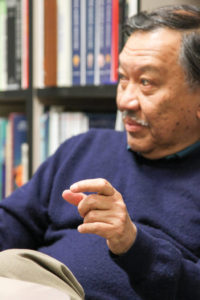The National Institute on Drug Abuse estimated that 2.1 million Americans misused prescription opioid pain relievers in 2012. In 2014, Utah was ranked seventh in the nation for “drug poisoning deaths,” most of which were related to prescription opioids.
Opioids are the most powerful class of pain relievers available for prescription by a doctor. This category includes drugs such as oxycodone, methadone, codeine and morphine. Fifty-five percent of deaths related to prescription opioids involve oxycodone. Methadone is also high risk in terms of mortality.
There are numerous reasons why prescription opioids make people vulnerable to addiction.
The receptors in the body through which the drugs work gradually become less sensitive, and use of opioids over long periods of time can actually make pain worse. Both of these side effects can lead to patients taking higher doses of the drug or taking them more frequently than prescribed. These behaviors can lead to addiction, overdose and death.
Despite the danger, these drugs are often effective at treating extreme chronic pain when used as directed, which is why they continue to be prescribed. In some cases, cancer patients being treated with chemotherapy experience pain so intense their treatment has to be stopped. Opioids are an option for these individuals.
At the University of Utah, efforts are underway to not only find ways to safely treat patients with opioids, but to combat their misuse and learn about how they affect the body.
Patient education is important at the Huntsman Cancer Institute at University Hospital where opioid pain relievers are commonly prescribed. A flyer that describes some of the risks associated with the drugs is given to all patients. It notes the dangers of combining other drugs, the possibility of addiction and what patients should do when they encounter side effects.
In 2009, Utah’s Health Department published guidelines for doctors on the process of prescribing pain relievers. The report defined which patients are considered at-risk for opioid misuse and included a contract that both doctors and patients are required to sign indicating that a patient understands their treatment plan. In the contract the patient must acknowledge that opioids may not make pain disappear completely and that their use “will result in the development of a physical dependence on this medication.” They also must agree to not take the medication inappropriately and to submit to random drug tests. The contract says that failure to comply may result in suspension of the drug therapy for the patient.
University of Utah Health Care also has a Pain Management Center designed to help patients confront pain without relying solely on opioids. It provides behavioral medicine-treatment from psychologists that “[teaches] patients about their pain and how to manage or respond to it” by “[addressing] personal, medical, interpersonal and behavioral issues that are important to the understanding and management of chronic pain.” The center also provides physical therapy in an effort to reduce, rather than simply treat, a patient’s pain over time.
Dr. Scott Junkins, medical director at the Pain Management Center, called its approach “team-based and interdisciplinary”. Medical specialists, pain psychologists, physical therapists and pain medicine physicians all work together to “evaluate patients and formulate treatment plans that are meant to help patients manage their pain themselves in the context of appropriate medical care.”
The U isn’t just teaching patients about the opioids they’re prescribed. Researchers are working to find a solution to the problem.
Eric Garland, the associate dean for research in the College of Social Work, is currently studying the ways that “mindfulness” can help patients who are prescribed opioids avoid misuse and the possibility of addiction or overdose.
Some faculty members are attempting to replace opioids entirely.
 Baldomero Olivera, a professor of biology, just finished working with a team of researchers to publish a study that suggests there may be an alternative to opioids that doesn’t carry the possibility of addiction.
Baldomero Olivera, a professor of biology, just finished working with a team of researchers to publish a study that suggests there may be an alternative to opioids that doesn’t carry the possibility of addiction.
Olivera’s lab studies toxin-secreting snails whose toxins act on the receptors between nerves and muscles to create pain. There are many types of these receptors, and most toxins seem to act on more than one kind. However, his lab found a snail whose toxins affect only one type of receptor.
A few years prior, a research group in Australia found a snail toxin that was “useful in preventing pain after nerve injury.” Olivera explained, “they tried to develop it commercially,” but it unexpectedly failed in human clinical trials after successful tests on animals.
Another researcher in Olivera’s lab, Michael McIntosh, was looking at specific receptors found in mammals called alpha9 and alpha10 and discovered that the toxin discovered by Australian researchers affected the receptor. He found that the compound was active on the receptor in rats, but not in humans.
“There was about a 10,000-fold difference in potency,” Olivera said.
The toxin observed in Olivera’s lab also worked on the receptor. It was more potent and more specific to that receptor than the Australian toxin was, but it also had a gap in potency levels between animals and people. To address this discrepancy, they changed the toxin’s makeup until it worked on the receptors of both rats and humans. They call it RgIA4.
When opioids are taken, they act on a different receptor that releases chemicals into the pleasure centers of the brain — one of the reasons their long-term use can lead to dependency. Because RgIA4 doesn’t act on the same receptor as opioids, Olivera’s lab believes it would not lead to addiction in this way, but he said the compound needs more testing.
Not only would the substance Olivera is researching prevent drug abuse, his team thinks that it would go beyond relieving pain to prevent it.
 “After a nerve injury and, by implication, after chemotherapy, you cause some nerve damage to tissues, and that damage then signals an immune response,” said Olivera. The hypothesis is that the tissue undergoes inflammation, “and your white blood cells begin to attack the damaged tissue. That sets off a series of events that ultimately leads to pain. What we think we’re doing [with RgIA4] is cutting those series of events so that the pain does not occur.”
“After a nerve injury and, by implication, after chemotherapy, you cause some nerve damage to tissues, and that damage then signals an immune response,” said Olivera. The hypothesis is that the tissue undergoes inflammation, “and your white blood cells begin to attack the damaged tissue. That sets off a series of events that ultimately leads to pain. What we think we’re doing [with RgIA4] is cutting those series of events so that the pain does not occur.”
“In other words,” he said, “we’re interfering with the progression to the pain state, not just relieving the symptoms.” Olivera noted that the compound also relieves the symptoms of pain.
In animal trials, the subjects don’t feel pain at all.
While RgIA4 only stays in the system for a few hours, the effects last many days.
They hope the compound is used in the future to create a drug. Olivera said there’s already one pain reliever made from a snail toxin on the market, so “it’s not out of the question.” He said he’s especially hopeful that RgIA4 becomes a drug because of its possible application to chemotherapy patients, as it “clearly would have an immediate benefit for people who have very severe cancer.” Many cancer patients stop or reduce treatment after pain becomes too severe.
Olivera said the process of drug creation is out of their hands because the research required to do so is costly and time-consuming, but “there may be a way to get things done faster, because you could argue that there’s an urgent need for people who have certain types of cancer.”
The research group Olivera works with wants to move forward with experiments to better understand exactly how the drug works. He said it brings up a “basic science question” of why chronic pain exists at all and what role the receptor — alpha9 alpha10 — plays in the pain response. It suggests that the receptor is an “essential participant on the road to pain,” he said.
Olivera said, “The implication [of studying how pain occurs] is that there may be other targets that we could use for preventing pain.”
@EliseAbril



